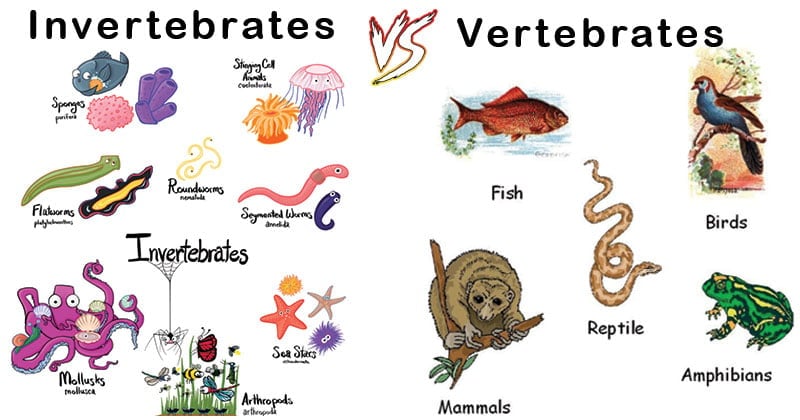The animal kingdom has been divided into two major groups: Invertebrates (Non-Chordates) and Vertebrates (Chordates). Invertebrates are those that do not possess a vertebral column or backbone while Vertebrates are those where vertebral column or backbone is present.

Interesting Science Videos
These two groups have some differences as follows:
|
S.N. |
Characteristics | Invertebrates (Non-Chordates) |
Vertebrates (Chordates) |
| 1. | Symmetry | Radial, Bi-radial or Absent | Bilateral |
| 2. | Metamerism | True or pseudo metamerism or Absent | True metamerism |
| 3. | Post-anal tail | Absent | Usually Present |
| 4. | Grade of organization | Protoplasmic or organ-system | Organ System |
| 5. | Germ Layers | Two (diploblastic), Three (Triploblastic) or Absent | Three (Triploblastic) |
| 6. | Coelom | Acoelomate, pseudocoelomate or Truly coelomate | Truly coelomate |
| 7. | Limbs derivation | From the same segment | From several segments |
| 8. | Notochord | Notochord or Backbone Absent | Present at some stage or replaced by a backbone made of ring-like vertebrae |
| 9. | Gut position | Dorsal to the nerve cord | Ventral to the nerve cord |
| 10. | Pharyngeal gill-slits | Absent | Present at some stage of life |
| 11. | Anus | Opens on the last segment or Absent | Differentiated and opens before the last segment |
| 12. | Blood vascular system | Open, Closed or Absent | Closed and much developed |
| 13. | Heart | Dorsal, Lateral or Absent | Ventrally placed |
| 14. | Dorsal blood vessel | Blood flows anteriorly | Blood flows posteriorly |
| 15. | Hepatic portal system | Absent | Present |
| 16. | Hemoglobin | In plasma or Absent | In red blood corpuscles |
| 17. | Respiration | Through body surface, gills or tracheae | Through gills or lungs |
| 18. | Nervous System | Solid | Hollow |
| 19. | Brain | Above pharynx or Absent | Dorsal to pharynx in head |
| 20. | Nerve cord | Double, ventral, usually bearing ganglia | Single, dorsal, without ganglia |
| 21. | Segmental nerve roots | Dorsal and ventral roots not separate | Dorsal and ventral roots separate |
| 22. | Reproduction | Asexual reproduction predominant | Sexual reproduction predominant |
| 23. | Regeneration power | Usually good | Usually poor |
| 24. | Body temperature | Cold-blooded | Cold or warm-blooded |
References
- Kotpal RL. 2017. Modern Text Book of Zoology- Invertebrates. 11th Edition. Rastogi Publications.
- Jordan EL and Verma PS. 2018. Invertebrate Zoology. 14th Edition. S Chand Publishing.

Thanks for yr research
Your notes have helped me so much